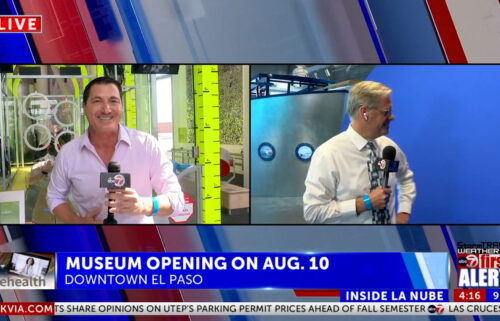Connecticut companies see sensors as game-changing technology
Click here for updates on this story
WALLINGFORD, Connecticut (Hartford Business Journal) — When Wallingford-based Amphenol Corp. announced plans last month to acquire sensor-technology company MTS Systems Corp. for $1.7 billion, the price tag was eyebrow-raising, but the strategy made sense.
“For many many years, we have seen more and more of our interconnect products being married together with some type of a sensor,” said R. Adam Norwitt, CEO of Amphenol, which makes electrical, electronic and fiber optic connectors, cables and interconnect systems for the telecommunications, aerospace and other industries. “We see demand for sensors growing, really, across all the markets where we’re focused.”
Norwitt’s not the only one who sees growth opportunities in sensor technology, which is expected to blossom globally into a $287 billion industry by 2025, according to Allied Market Research.
From Fortune 500 companies to small startups, Connecticut businesses are increasingly staking out positions in the sensor-technology space, adding or developing products and services that help detect changes in the environment — like heat, motion or pressure — and then alert users to that data and information.
Such technology is commonly used in consumer electronics, but it’s being adopted at a rapid pace by businesses in myriad industries to make their operations, products or services more efficient and profitable.
For example, property and casualty insurers are using sensor technology to help customers detect potential faulty equipment to prevent prolonged and costly breakdowns. Healthcare providers, particularly in the wake of COVID-19, are using it to track patient health metrics from afar. And manufacturers are using it to streamline their production lines.
Some experts say that in a matter of years, the technology could fundamentally change all three of those sectors, which are key to Greater Hartford’s economy.
“We’re really optimistic about the market for sensor technology,” said Lannie Moore, co-founder of Oval Digital Inc., a startup honing its in-home sensor technology at Upward Labs’ Hartford accelerator program. “One of these days soon, sensors will be standard in any office, or apartment building just like brakes are in a car.”
Connecting digital, physical worlds
Amphenol’s first major investment in sensor technology came about seven years ago, when it acquired for $318 million General Electric’s Advanced Sensors business, which makes sensor products for the transportation and automotive, medical and other industrial markets. Norwitt said he noticed that an increasing number of manufacturing technologies were using sensors to measure and improve the production process. Since Amphenol makes components used to connect manufacturing electrical systems, Norwitt said, it made sense to start selling sensor devices as well.
Amphenol’s purchase of Minnesota-based MTS — which makes systems that perform product testing on vehicles, civil engineering systems and other products — marked its eighth acquisition of a sensor-technology company, Norwitt said, but it probably won’t be the last. That’s because the ability to track physical data (i.e. temperature, pressure, motion, etc.) is at the cutting edge of many emerging markets.
“When you think about [anything from] smart manufacturing to autonomous driving, all of these require a connection to the physical world that’s brought into the digital world,” Norwitt said. “And once data is in the digital world, there’s a lot that you can do with it.”
George Bollas, director of the UTC Institute for Advanced Systems Engineering at the University of Connecticut, said sensor technology is already allowing manufacturers to adjust processes for efficiency and fix minor problems before they become big issues. For example, a medical device company can use sensor technology to figure out that an automated screwdriver is loose and needs to be replaced before it breaks. The company could also track data from its entire manufacturing process, and find that altering the order in which the product is assembled saves time or material.
“Converting the information to something that the operators can read and understand and get support for decision making … is one of the aspects of this technology that will actually bring significant benefits to the [manufacturing] industry,” Bollas said.
Sensor technology is also making waves in the insurance industry, said Gordon Hui, a vice president focusing on internet-connected — or Internet of Things — products at Hartford Steam Boiler.
HSB, a specialty insurer and provider of engineering risk management and technology services, has long understood the value of avoiding disasters before they happen, Hui said. One of the major services the company originally offered upon its founding in 1866 was inspecting industrial steam boilers, in order to take them offline before they exploded — a frequent, fatal and costly occurrence years ago.
The company established a “sensor team” in 2013, and began investing in startups using sensor technology the following year, Hui said. In the past six years, HSB has partnered with and invested in early-stage startup companies—like Augury which uses sensors to track the health and performance of industrial manufacturing machines; and relayr Inc., which tracks data from machines and production lines to provide insights into critical failures and efficiency levels.
Today, HSB uses sensor technology to monitor clients’ property, and warn them when a pipe is about to burst, or an electrical system is in danger of an outage. A few months ago, HSB warned the Newington Public School District, which has been running a free meals program throughout the pandemic, that its freezer was registering higher-than-usual temperatures, Hui said. Using that sensor data, HSB identified which part was causing the problem, and the client replaced it before the freezer went down and food spoiled.
“What could have been a major loss to the community became a minor issue,” Hui said. “This remote monitoring is helping many of these businesses prevent risk at a time when they really need extra support.”
Further, Hui thinks the ability to prevent accidents that lead to property damage could turn the insurance industry on its head within the next five or so years.
“It’s going to be about predicting and preventing loss, and not just about paying out for losses,” Hui said. “I think that is going to be a huge sea change for the industry.”
Startups to stalwarts
Smaller companies working in Hartford are getting into sensor technology, too, like Oval Digital Inc., which makes a wireless in-home device that monitors changes in temperature, light, humidity, motion and water.
The New York-based company, which was founded in 2014, is currently participating in the Upward Labs startup accelerator in Hartford, CEO Michael Harry said. Selling home-monitoring devices didn’t have much appeal with the public until millions of people started buying and using Amazon’s Alexa or Google Home, Harry said.
“It wasn’t really resonating with a lot of homeowners, because there was a learning curve of educating them on what this was, what it can do and why they would need it,” Harry said.
Now Oval’s home device is available on Amazon, and the company is looking to expand into selling the product to property managers, who could use it to identify problems with a building’s HVAC and other systems, before tenants complain, said Moore, the company co-founder.
Farmington-based Otis Worldwide Corp. was already using sensor technology to monitor the brakes on its elevators before it began releasing a slate of touchless sensor-based products in 2020 that allow passengers to control an elevator with their voices and hand gestures, said Chris Smith, the company’s vice president of marketing and product strategy.
There is also the company’s IoT program called Otis ONE, which uses sensors to detect problems with an elevator, and reports issues to Otis maintenance crews to help streamline repairs, Smith said. About a quarter of Otis’ elevators around the world are sensor-enabled, he said, and that will rise as old ones are replaced or retrofitted.
“In 10 years, people are going to expect that there is certain information and data that you can get from the elevator that customers want access to,” Smith said.
Please note: This content carries a strict local market embargo. If you share the same market as the contributor of this article, you may not use it on any platform.




